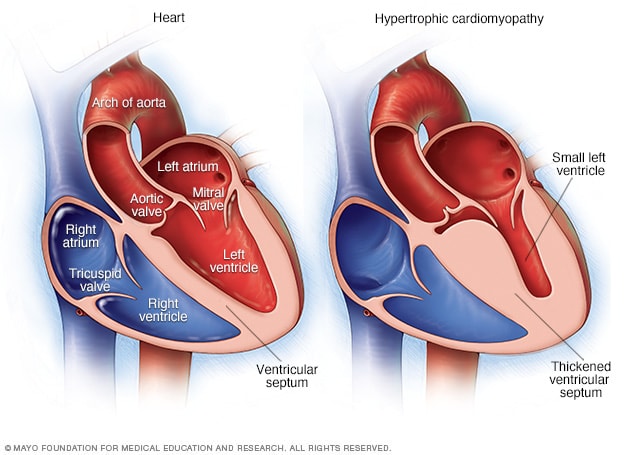Overview
Hypertrophic cardiomyopathy

Hypertrophic cardiomyopathy
In hypertrophic cardiomyopathy (HCM), the muscular heart walls (septum) are much thicker (hypertrophied) than those in a typical heart. The thickening can occur anywhere in the left lower heart chamber (left ventricle).
Hypertrophic cardiomyopathy (HCM) is a disease in which the heart muscle becomes thickened (hypertrophied). The thickened heart muscle can make it harder for the heart to pump blood.
Hypertrophic cardiomyopathy often goes undiagnosed because many people with the disease have few, if any, symptoms. However, in a small number of people with HCM, the thickened heart muscle can cause shortness of breath, chest pain or changes in the heart's electrical system, resulting in life-threatening irregular heart rhythms (arrhythmias) or sudden death.
Symptoms
Signs and symptoms of hypertrophic cardiomyopathy might include one or more of the following:
- Chest pain, especially during exercise
- Fainting, especially during or just after exercise or exertion
- Heart murmur, which a health care provider might detect while listening to the heart
- Sensation of fast, fluttering or pounding heartbeats (palpitations)
- Shortness of breath, especially during exercise
When to see a doctor
A number of conditions can cause shortness of breath and fast, pounding heartbeats. It's important to get a prompt, accurate diagnosis and appropriate care. See your health care provider if you have a family history of HCM or any symptoms associated with hypertrophic cardiomyopathy.
Call 911 or your local emergency number if you have any of the following symptoms for more than a few minutes:
- Rapid or irregular heartbeat
- Difficulty breathing
- Chest pain
Causes
Hypertrophic cardiomyopathy is usually caused by changes in genes (gene mutations) that cause the heart muscle to thicken.
Hypertrophic cardiomyopathy typically affects the muscular wall (septum) between the two bottom chambers of the heart (ventricles). The thickened wall might block blood flow out of the heart. This is called obstructive hypertrophic cardiomyopathy.
If there's no significant blocking of blood flow, the condition is called nonobstructive hypertrophic cardiomyopathy. However, the heart's main pumping chamber (left ventricle) might stiffen. This makes it hard for the heart to relax and reduces the amount of blood the ventricle can hold and send to the body with each heartbeat.
People with hypertrophic cardiomyopathy also have a rearrangement of heart muscle cells (myofiber disarray). This can trigger arrhythmias in some people.
Risk factors
Hypertrophic cardiomyopathy is usually passed down through families (inherited). People with one parent with hypertrophic cardiomyopathy have a 50% chance of having the genetic mutation for the disease.
Parents, children or siblings of a person with hypertrophic cardiomyopathy should ask their health care providers about screening for the disease.
Complications
Complications of hypertrophic cardiomyopathy can include:
- Atrial fibrillation. A thickened heart muscle and changes in the structure of heart cells can cause changes in the heart's electrical system, resulting in fast or irregular heartbeats. Atrial fibrillation can also increase the risk of developing blood clots, which can travel to the brain and cause a stroke.
- Blocked blood flow. In many people, the thickened heart muscle blocks the blood flow leaving the heart, causing shortness of breath with exertion, chest pain, dizziness and fainting spells.
- Mitral valve disease. If the thickened heart muscle blocks the blood flow leaving the heart, the valve between the left atrium and left ventricle (mitral valve) might not close properly. As a result, blood can leak backward into the left atrium (mitral valve regurgitation), possibly making symptoms worse.
- Dilated cardiomyopathy. In a small number of people with HCM, the thickened heart muscle becomes weak and ineffective. The ventricle becomes enlarged (dilated), and it pumps less forcefully.
- Heart failure. The thickened heart muscle can eventually become too stiff to fill the heart with blood. As a result, the heart can't pump enough blood to meet the body's needs.
- Fainting (syncope). An irregular heartbeat or blockage of blood flow can sometimes cause fainting. Unexplained fainting can be related to sudden cardiac death, especially if it's happened recently and in a young person.
- Sudden cardiac death. Rarely, hypertrophic cardiomyopathy can cause heart-related sudden death in people of all ages. Because many people with hypertrophic cardiomyopathy don't realize they have it, sudden cardiac death might be the first sign of the condition. It can happen in seemingly healthy young people, including high school athletes and other young, active adults.
Prevention
There is no known prevention for hypertrophic cardiomyopathy. It's important to identify the condition as early as possible to guide treatment and prevent complications.
If you have a first-degree relative — a parent, sibling or child — with hypertrophic cardiomyopathy, you might be referred for genetic testing to screen for the condition. However, not everyone with HCM has a currently detectable mutation. Also, some insurance companies don't cover genetic testing.
If genetic testing isn't done, or if the results aren't helpful, then a health care provider might recommend repeated echocardiograms if you have a family member with hypertrophic cardiomyopathy. Adolescents and competitive athletes should be screened once a year. Adults who don't compete in athletics should be screened every five years.